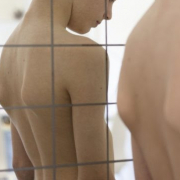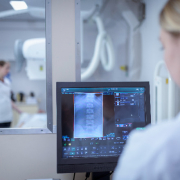Our patients’ questions are often opportunities to provide useful information to them and others.
Francesco’s questions prompted us to examine the possible correlation between scoliosis, degrees of curvature, and height growth.
“Let me start by describing my particular experience: at the age of 17 and a half, in a skiing accident, I injured my patellar tendon, which was operated on and then put in a brace for 30 days. Once I had recovered and regained full mobility, I had a physiatrist colleague of my father who examined me. During the examination, he measured my height (178 cm) and checked my back, remarking that I perhaps had very mild scoliosis (there was no talk of X-rays, much less of degrees of curvature and so on). Let’s just say that I took the information on board and left it at that.
This year, I had a checkup with the same physiatrist, who, upon seeing me, was immediately struck by how much taller I had grown: he measured me, and I was 184 cm.
I’m sure I’m not unique, but I would guess it’s rare for a boy of 17 and a half to gain another 6 cm.
He looked at my back and told me it was “a bit worse”. I was quite upset about that because, being completely ignorant on the subject (like anyone who has no direct experience of this deformity), I had imagined it was something that could be remedied by improving my posture or through physical activity. He reassured me that by now it should have stabilised (“stable until proven otherwise” as you say) and not to worry about it too much. This time, though, he recommended an X-ray.
From the X-ray, I learned that my latest growth had done me more harm than good and had seemingly affected my scoliosis more than anything. Also, at the initial examination, I’d had a much chubbier, more child-like physique, which at the time might have helped to mask the scoliosis somewhat. Functionally, though, I have no pain (since, as you have told me, my curve is moderate), and fortunately, aesthetically, it is not too noticeable.
So, here are my two questions:
- Given that the human body generally declines with age, does that mean I am at risk of becoming, in the future, one of those old men you see with a walking stick, bent over and crooked? In other words, even though my scoliosis shouldn’t get worse in adulthood, am I more likely than someone without scoliosis to end up like the kind of elderly person I just described?
- Is there a relationship, however approximate, between the number of Cobb degrees and the number of cm lost in height? I have read that you lose 1 cm in height for every 10° of Cobb angle, and therefore that you can divide your degrees of curvature by 10 to work out how much height you’ve lost”.
Here is our response.
First of all, it’s not unusual for males to gain a few more centimetres after reaching the age of 17. In fact, height growth is linked to skeletal maturation, a process that in boys begins and therefore also ends a few years later than in girls. Scoliosis is a pathology that, to worsen, exploits bone growth, accentuating the vertebral deformity; this could explain the clinical findings from your latest examination.
As regards height “lost” due to scoliosis, I would say that having reached around 1.85 m, you can’t really complain …! That said, to answer your question, with a 30° curve you lose 1–1.5 cm at most.
Some international scientific journals have published mathematical formulas for calculating centimetres lost due to scoliotic curvature(s) of the spine.-
These calculations also take into account the ratio between height when seated (trunk and head) and height when standing.
The studies published on this topic evaluated scoliosis cohorts (between 140 and 1500 subjects enrolled) and reported an average height loss of 3.38 cm for females and 2.86 cm for males.
The formulas providing the most valid estimates of height loss are those of Kono and Stokes, according to which a scoliotic curve of 80° seems to lead to a loss of between 3.5 and 5.5 cm, while one of 100° appears to correspond to between 4.5 and 8.5 cm in lost height. The greater the curve, the more the estimates produced by the two formulas differ; instead, they give comparable results for smaller curves.
Patients with severe curves also tend to ask surgeons about height, but in terms of gain, asking: “How many extra cm of height will this operation give me?” The answer to this question is less certain, because there are too many factors at play, so many in fact that no pre-surgical prediction can be considered reliable.
As for your concerns about adulthood and old age, you will understand that I can only reply in very general terms. With curves of around 30° at the end of growth, the risk of the condition worsening over future decades is very low.
It’s like someone with slightly raised cholesterol or high blood pressure asking me: am I going to have a heart attack in a few decades’ time? Although high cholesterol levels, systemic arterial hypertension, a sedentary lifestyle and other factors are associated with increased cardiovascular risk, it isn’t possible to translate estimates of the risks associated with a specific disease into a clear prediction for an individual case.
In terms of prevention, in adults with scoliotic curves similar to yours, regular physical activity is recommended in order to maintain good general muscle tone, able to counteract the worsening effect that gravity would otherwise have on the curves over the years.



